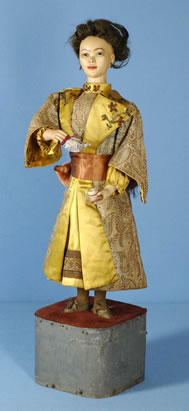Made to move
Natural forces
You can move some toys very simply – by pushing, pulling or turning. The power comes from your hand. When you stop pulling or pushing, the toy stops working.
The horse below was probably made between 1850 – 1900. It is made of wood, with a painted ghesso, or plaster, layer over the top. It stands on a wooden platform with tiny metal wheels, so that it can be pulled along.
Toys like Yo-Yos use the natural force of gravity to make them rise and fall. The below ‘boy on a goose’ painted wooden toy dates from c.1900 – 1920. It has small lead weights under the bird’s neck and tail. This makes the goose rock backwards and forwards.
Springs and coils

Japanese doll
Some toys use the power of springs and coils. A ‘Jack-in-the-Box’ stores energy in a coiled spring. When you lift the lid, the energy is released, and ‘Jack’ jumps up.
Clockwork toys store energy in a wound spring. You wind the spring up with a key. When you let go, the spring unwinds and releases energy slowly to make the toy move.
This Japanese-style figure was probably made in Germany, c.1880 – 1900. You turn the key to wind the mechanism. When you release the brake, music plays and the figure pours out tea.
This ‘doll in a rose’ toy was also probably made in Germany, c.1880 – 1900. When you turn the key to wind the mechanism, the flower opens and the doll pops up. You can push the brake to make it stop.
Clever joints
Some toys move because they have clever joints. Dolls with jointed bodies are more fun to play with – you can make them bend and sit.
The dog below was made between 1700 – 1800. It is made of metal on a wooden base. It has jointed legs, which move when you turn the cogs.
String puppets have jointed bodies, with strings attached to the different parts. By working the strings, you can make the puppet move. This toy was made in England by Pelham Puppets, c.1960 – 1965. It is made of painted wood. When you pull the strings, the jointed parts of the puppet move.
Look - no hands!
Energy sources like electricity give toys the power to move on their own. Electric circuits are powered by motors.
The energy comes either from batteries, or mains electricity. This toy train, c.1950 – 1960, was made in England by Hornby Meccano Ltd. It runs on electricity. The ‘Mamod’ steam engine, c.1930 -1960, uses a solid fuel tablet to provide heat to make it move.




